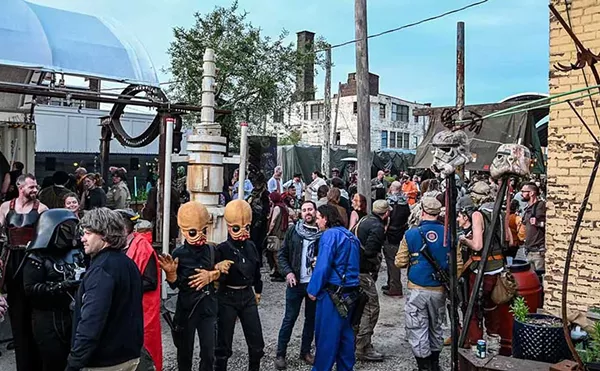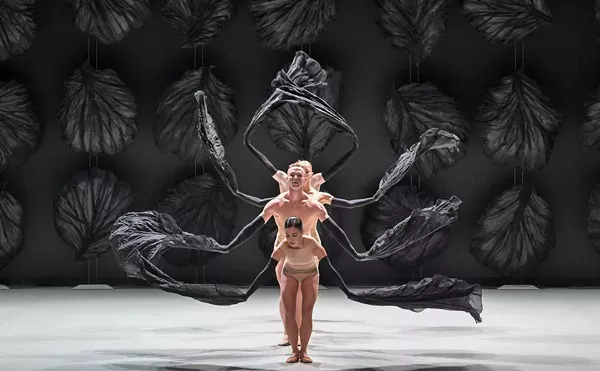
Audio By Carbonatix
[
{
"name": "GPT - Leaderboard - Inline - Content",
"component": "35519556",
"insertPoint": "5th",
"startingPoint": "3",
"requiredCountToDisplay": "3",
"maxInsertions": 100,
"adList": [
{
"adPreset": "LeaderboardInline"
}
]
}
]
Perhaps all that space was making her homesick. —Louise Erdrich
Carrie Mae Weems, an internationally celebrated visual artist, recently came to town to launch her show at the Susanne Hilberry Gallery in Ferndale. The artist has said that the focus of her work is “to describe simply and directly those aspects of American culture in need of deeper illumination.”
The show is magnificent. Moving through the Hilberry’s elegant presentation of the works, it’s as if Weems gives a time-warp history lesson in sepia tones. Her photographs and photographic-reproductions are grand, large-scale and exquisite in quality. Humongous photographs depicting tragedies of African-American and Native American history leaves one with a sad, hollow pit in the stomach, like being slugged, but nonetheless awestruck by the impressive scale and emotion, and of the subtleties of meaning captured by the artist.
Folklore is a constant theme for Weems. Her photographs probe the political and social forces that act upon the human subject, and the human resistance to those forces. Each figure, whether a person, a room or a physical object, is tied to a historical narrative. To varying degrees, Weems’ subjects are displaced from their pasts, cut off from their roots. Her art examines the juxtaposition of newfound lives and the raw longing to connect with a sense of home or with geographic and personal ancestry. She herself may be able to relate to such feelings, as her family emigrated from Mississippi to her hometown of Portland, Oregon, where she was born in 1953.
A definitive series called “The Hampton Project” occupies nearly half of Weems’ solo exhibit at the Hilberry. The works examine the Hampton Institute, a Virginia school founded in 1868 (during the Reconstruction Era) for African-Americans (initially freed slaves) and North American Indians. Participants received a scientific and liberal arts education, training for home and farm economics and lessons in social etiquette.
The institute captivates Weems. On the one hand it offers training and advancement opportunity; on the other, it thrusts participants into assimilation programs. The institute still exists as a college.
“A gold mine and a land mine,” is how Weems describes the massive amount of archival material she discovered about the institute.
Some of “The Hampton Project” works come from a series of photographs taken in 1899 by a white photojournalist, Frances Benjamin Johnston. Weems digitally reprinted some of Johnston’s images onto huge, sheer sheets of muslin, which hang suspended from the Hilberry Gallery’s ceiling. Others are reprinted on canvas.
One of the suspended muslin pieces, “Old Folks At Home,” depicts the disquieting scene of a couple, two newly released slaves, wearing a stiff Victorian ruffled dress and bonnet and a starched suit, sitting upright at a dining table. Another, “Alumnae. Alumnus,” is a yearbook class portrait of two beaming 1950 Hampton Institute graduates.
Two of the saddest images on canvas, part of “The Armstrong Triptych,” are placed next to each other: one photograph portrays a group of Native American men wrapped in traditional blankets; the other portrays the same group of men “re-formed,” dressed in ill-fitting European trousers and jackets.
Words are blocked on some of the canvases, to great effect.
“Untitled, Weems and Buffalo,” taken by the late David Wojnarowicz, is a haunting scene of buffalo toppling, head first, off a cliff. Weems places herself in the frame, back to the viewer, looking at the image. Superimposed are the words: “FROM A GREAT HEIGHT I SAW YOU FALLING BLACK & INDIAN ALIKE AND FOR YOU I PLAYED A SORROW SONG.”
A series titled “May Days Long Forgotten” includes portraits of blossoming white roses and powerful little girls. One in this series, “After Manet,” references French Impressionist Edouard Manet’s classic 1863 painting of a kept woman, “Olympia.” The original painting depicts a naked white woman sprawled on a bed, gazing at the viewer. Behind her a black woman (presumably a maid) presents her with a flower bouquet. At the foot of the bed stands a black cat gazing out of the frame. Weems’ piece is a careful response, formally and thematically. She replaces the four figures in the Manet painting (two women, a cat, the flowers) with four young girls, sprawled on the grass and leaning on each other, gazing at the viewer. The girls evoke a sense of youthful confidence. The flowers are no longer bunched and packed in a bouquet but spread into designs dotting the girls dresses. Weems takes notions of ownership and power from the original painting, depicting a black slave girl owned by the white harlot, in turn owned by men (Manet's painting itself was a commentary on similar such Venus paintings throughout the ages, including one by Goya and the famous Titian) and turns the notions on their head. Weem's Manet revision gives full stage to powerful young black girls — a vision of freedom and optimism, owned by nobody. The title’s connection, “May Day/Carrie Mae,” suggests the artist’s younger self.
Such potent sparks of human connection are characteristic of this exhibition, at once deeply rooted in history and visually stunning.
The Weems show runs through April 3 at the Susanne Hilberry (700 Livernois, Ferndale). The gallery is open Tuesday through Saturday, 10 a.m. to 6 p.m. Call 248-541-4700.
Lynn Crawford is an art critic who freelances for Metro Times. E-mail letters@metrotimes.com




